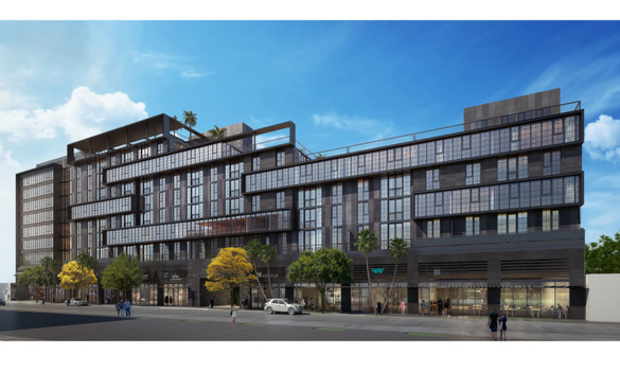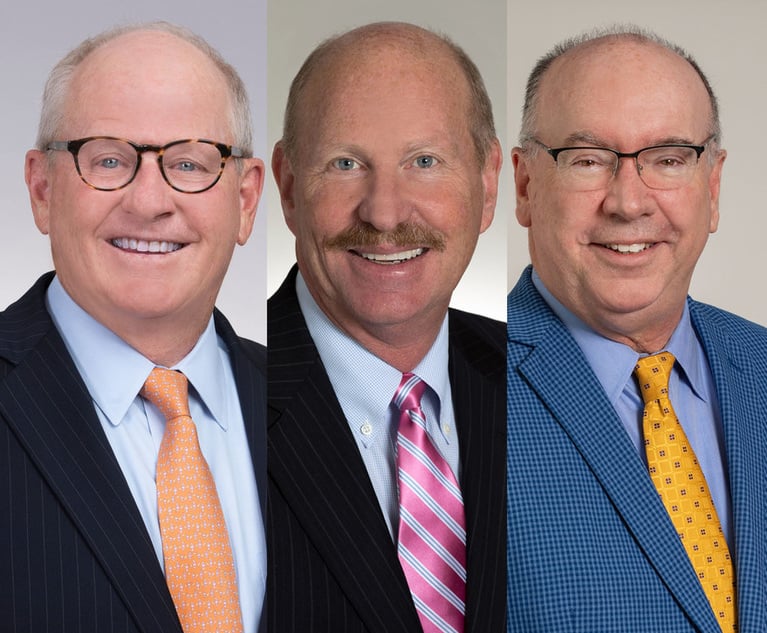Micro-Living Coming to Unincorporated Miami-Dade County? Code, Zoning Changes Considered
Five staff recommendations would encourage micro-housing as another tool to counter the affordable housing crisis.
January 04, 2019 at 03:18 PM
5 minute read
 Rendering of Wynwood 25, a project under construction in Miami's Wynwood neighborhood offering micro-apartment units.
Rendering of Wynwood 25, a project under construction in Miami's Wynwood neighborhood offering micro-apartment units.
Miami-Dade County is considering tackling the affordable housing shortage in part by encouraging micro-units — in spite of reluctance by developers to build tiny and mixed reviews elsewhere.
One of the issues is that a very small apartment doesn't necessarily mean an affordable one, according to a Miami-Dade study.
Several Miami projects have been dubbed micro-unit buildings at various stages of development, but none offer units smaller than 400 square feet. The city in December 2017 authorized 275-square-foot apartments, down from the previous floor of 400. But no plans have been filed with the city to build that small.
Even without a track record, Miami-Dade planners are offering five recommendations on code and other changes to encourage micro-units in unincorporated areas.
Three offerings would be apartments called micro-units, small single-family homes and accessory dwellings, or small detached units on the same lot as a single-family home.
The county's current standard is 260-square-foot micro-units and tiny homes as well as 400-square-foot accessory dwellings. But they are allowed only on some lots and with unit-per-acre restrictions. Some areas in the county allow as much as 125 units and others as few as six units per acre, according to staff from the Department of Regulatory and Economic Resources.
The recommendations are meant to be another tool to fight the affordable housing crisis with emphasis on transit access. Micro-units would be allowed within a half-mile of Metromover, Metrorail and express bus stops, higher density would be permitted, and parking requirements would be eased, according to a Dec. 10 county report and staff interviews.
Another recommendation would open public land as a site option with the county selling its land below market rate.
While the County Commission unanimously voted Dec. 18 to accept the staff report, the vote amounted to an acknowledgement of the report. Before changes could be made, a commissioner would need to seek draft legislation and a commission majority would need to approve.
The county analyses of micro-living elsewhere showed price per square foot in a micro-unit is higher than standard apartments. In Seattle's core, the average micro-unit rent is $5 per square foot compared with $3.42 for a studio.
Ultimately, the county staff concluded the best way to ensure affordability would be to mandate affordable pricing in a percentage of the units. That's why staff recommended 12.5 percent of the apartments in a micro-unit project near transit should be priced affordably for those earning up to 80 percent of the area median income.
“The point here is how do we encourage affordable housing, how do we provide for housing affordability throughout the county because the typical housing stock that's being built is not necessarily affordable. Micro-housing is seen as one possible option,” said Garett Rowe, chief of metropolitan planning in the county Department of Regulatory and Economic Resources' planning division.
One New York micro-unit project mandated reserving 40 percent of the units as affordable. The rent per square foot for the other 60 percent was nearly double the city average, according to a Miami-Dade staff study.
Some of the micro-unit projects underway in Miami are The Related Group and East End Capital's 289-unit Wynwood 25 and The Related Group and Block Capital Group's 172-unit Wynwood 26 apartment buildings, where the smallest units would be 400 square feet; The Related's 192-unit VHouse Wynwood, where the smallest units would be 416 square feet; and Moishe Mana's 49-story apartment tower at 200 N. Miami Ave., were the smallest units would be 400 square feet.
One Miami Beach project is dropping below 400 square feet. The smallest unit at the high-end 70-unit condo-hotel at 6080 Collins Ave. will have 350-square-foot studios for purchase. Domus Group has partnered with hotel company Eskape Collection to develop the project under a city provision setting a 335-square-foot minimum for new hotel rooms.
Other developers don't see the appeal.
“I don't see the market, the user for such a small unit,” said Andrew Hellinger, co-founder and principal of Coral Gables-based UrbanX Group, which is developing River Landing Shops and Residences on the Miami River. “Given the choice of living in a small micro-unit on a public-transportation way in a particular submarket or a larger unit in a different area of the city or the county, people are going to go to the larger units as long as the affordability is comparable.”
Even when developers are priced out of one area, they can migrate to another instead of having to build small, he said.
“When Brickell became too expensive, people started buying land in the Wynwood market,” Hellinger said. “That's become too expensive. They are going to the Allapattah market, the Little Havana market.”
Related stories:
The Incredibly Shrinking Home: Miami Beach Developer Down to 350 Square Feet
How Small Can You Go? Miami Eyes Micro-Units at 275 Square Feet
This content has been archived. It is available through our partners, LexisNexis® and Bloomberg Law.
To view this content, please continue to their sites.
Not a Lexis Subscriber?
Subscribe Now
Not a Bloomberg Law Subscriber?
Subscribe Now
NOT FOR REPRINT
© 2025 ALM Global, LLC, All Rights Reserved. Request academic re-use from www.copyright.com. All other uses, submit a request to [email protected]. For more information visit Asset & Logo Licensing.
You Might Like
View All
Fowler White Burnett Opens Jacksonville Office Focused on Transportation Practice
3 minute read
How Much Coverage Do You Really Have? Valuation and Loss Settlement Provisions in Commercial Property Policies
10 minute read
The Importance of 'Speaking Up' Regarding Lease Renewal Deadlines for Commercial Tenants and Landlords
6 minute read
Meet the Attorneys—and Little Known Law—Behind $20M Miami Dispute
Trending Stories
- 1'A Death Sentence for TikTok'?: Litigators and Experts Weigh Impact of Potential Ban on Creators and Data Privacy
- 2Bribery Case Against Former Lt. Gov. Brian Benjamin Is Dropped
- 3‘Extremely Disturbing’: AI Firms Face Class Action by ‘Taskers’ Exposed to Traumatic Content
- 4State Appeals Court Revives BraunHagey Lawsuit Alleging $4.2M Unlawful Wire to China
- 5Invoking Trump, AG Bonta Reminds Lawyers of Duties to Noncitizens in Plea Dealing
Who Got The Work
J. Brugh Lower of Gibbons has entered an appearance for industrial equipment supplier Devco Corporation in a pending trademark infringement lawsuit. The suit, accusing the defendant of selling knock-off Graco products, was filed Dec. 18 in New Jersey District Court by Rivkin Radler on behalf of Graco Inc. and Graco Minnesota. The case, assigned to U.S. District Judge Zahid N. Quraishi, is 3:24-cv-11294, Graco Inc. et al v. Devco Corporation.
Who Got The Work
Rebecca Maller-Stein and Kent A. Yalowitz of Arnold & Porter Kaye Scholer have entered their appearances for Hanaco Venture Capital and its executives, Lior Prosor and David Frankel, in a pending securities lawsuit. The action, filed on Dec. 24 in New York Southern District Court by Zell, Aron & Co. on behalf of Goldeneye Advisors, accuses the defendants of negligently and fraudulently managing the plaintiff's $1 million investment. The case, assigned to U.S. District Judge Vernon S. Broderick, is 1:24-cv-09918, Goldeneye Advisors, LLC v. Hanaco Venture Capital, Ltd. et al.
Who Got The Work
Attorneys from A&O Shearman has stepped in as defense counsel for Toronto-Dominion Bank and other defendants in a pending securities class action. The suit, filed Dec. 11 in New York Southern District Court by Bleichmar Fonti & Auld, accuses the defendants of concealing the bank's 'pervasive' deficiencies in regards to its compliance with the Bank Secrecy Act and the quality of its anti-money laundering controls. The case, assigned to U.S. District Judge Arun Subramanian, is 1:24-cv-09445, Gonzalez v. The Toronto-Dominion Bank et al.
Who Got The Work
Crown Castle International, a Pennsylvania company providing shared communications infrastructure, has turned to Luke D. Wolf of Gordon Rees Scully Mansukhani to fend off a pending breach-of-contract lawsuit. The court action, filed Nov. 25 in Michigan Eastern District Court by Hooper Hathaway PC on behalf of The Town Residences LLC, accuses Crown Castle of failing to transfer approximately $30,000 in utility payments from T-Mobile in breach of a roof-top lease and assignment agreement. The case, assigned to U.S. District Judge Susan K. Declercq, is 2:24-cv-13131, The Town Residences LLC v. T-Mobile US, Inc. et al.
Who Got The Work
Wilfred P. Coronato and Daniel M. Schwartz of McCarter & English have stepped in as defense counsel to Electrolux Home Products Inc. in a pending product liability lawsuit. The court action, filed Nov. 26 in New York Eastern District Court by Poulos Lopiccolo PC and Nagel Rice LLP on behalf of David Stern, alleges that the defendant's refrigerators’ drawers and shelving repeatedly break and fall apart within months after purchase. The case, assigned to U.S. District Judge Joan M. Azrack, is 2:24-cv-08204, Stern v. Electrolux Home Products, Inc.
Featured Firms
Law Offices of Gary Martin Hays & Associates, P.C.
(470) 294-1674
Law Offices of Mark E. Salomone
(857) 444-6468
Smith & Hassler
(713) 739-1250






